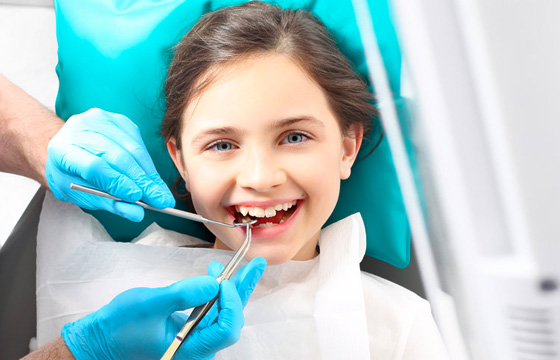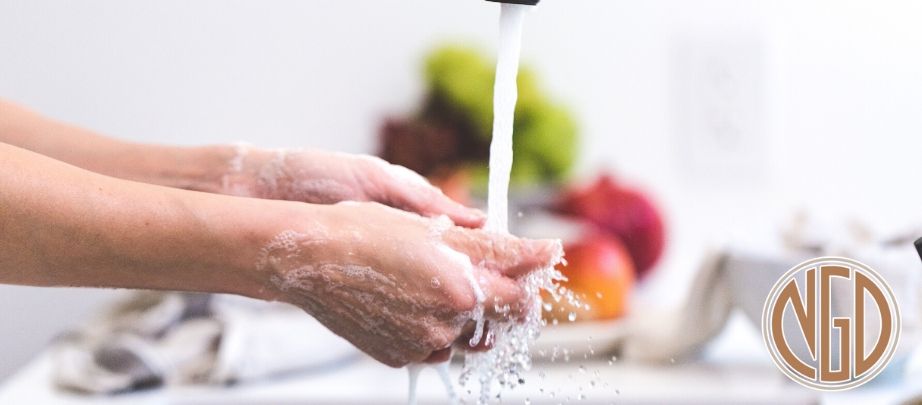Your child’s oral health starts at the dentist. Regular cleanings are the way to prevent cavities and tooth decay.
It is our main priority to keep your child cavity free and to do so, we take many precautions to keep them from getting any.

As important as it is to come into the office for checkups and pediatric dental cleanings, it is also important for you to teach your child how to properly brush and floss their teeth. Along with teaching your child how to brush and floss, a parent must also teach their child how to make smart food and beverage choices (i.e. choosing items that are less likely to cause tooth decay).
The first half of your child’s life is when they are at the highest risk of cavities. Keeping baby teeth clean is vital because if the teeth are healthy, the gums will also be healthy, contributing to the child’s overall well-being. Aside from regularly brushing and flossing, we recommend having your child get their teeth cleaned at least twice a year. These cleanings typically begin at around age three once the child’s teeth have all grown in. At these in-office teeth cleanings, the dentist will remove any plaque that has built up on the teeth over time.
These cleanings are extremely important because they work to remove the plaque that the toothbrush cannot. Coming frequently will also help your child become accustomed to the dentist, so that each time they come, their anxiety is reduced. It will also set a good example and show that dental hygiene is an important aspect of overall health. If your child comes in routinely and keeps up with their dental routine at home, they are sure to have a healthy smile.
What Happens During a Pediatric Dental Cleaning?
During the cleaning appointment, the teeth will be cleaned with an electric prophy brush and tooth polish. The polishing brush runs along all surfaces of the teeth to thoroughly clean every groove and crevice. For areas that tend to be more stubborn, hand instruments are used to manually remove plaque, especially in areas that are harder to reach.
Towards the end of the appointment, if the child is old enough, a fluoride treatment is done that can help to strengthen the tooth enamel. Depending on the fluoride treatment that is administered, your child may or may not be able to drink immediately after the treatment. If a varnish is used, they are able to eat and drink right away, but must avoid overly sugary foods and carbonated drinks. If a fluoride foam is used, they must avoid all food and water for at least thirty minutes to allow for the fluoride to activate. After the fluoride is applied to the teeth and sinks in, it is important to remember not to brush it off because the longer it is on, the more it will strengthen the teeth.
Professional prophylaxis, or teeth cleaning, is strongly encouraged for many reasons. During those early dental appointments, children and their parents will be instructed on the proper oral hygiene techniques that are appropriate for the child’s age. In addition to that, regularly removing plaque, stain, and calculus build up from oral cavity helps maintain the health of the mouth.
And most importantly, good habits start early. Introducing dental procedures to a young child helps them feel more comfortable in the dentist’s office when they are older.
How to Care for Your Child’s Teeth
Once your child begins to grow teeth, their oral health care routine needs to change as they grow. As babies, it is important to simply wipe down your child’s gums after each meal to remove any food debris or buildup. As your child grows up, this method of cleaning will not work and they must begin to create healthy oral care habits. Here are a few things to ways to keep your child’s teeth healthy as they grow older.
Diet & Nutrition
Start by simply teaching your child about the foods that they should be avoiding or eating sparingly. If they learn early on about the foods that are harmful for their health and the foods that can enhance their health, they will make wiser decisions in the future. Teaching them the reasoning behind everything they do helps them to understand and want to make better choices on their own. The foods that they should try to avoid and eat sparingly are ones that have a high sugar or acidity content. This is because sugar and acid tend to break down the enamel of the tooth.
Foods and drinks that can be helpful to their overall and dental health are:
- Dairy: Plain yogurt, cheese, milk
- Vegetables: Leafy greens (spinach & kale), carrots, celery
- Fruits: Apples, strawberries, citrus
Fluoridated water is also great for teeth. Consult your pediatric dentist about how much fluoridated water or fluoridated products are appropriate for your child. Fluoride is a naturally occurring mineral that can strengthen and protect enamel from cavities.
Brushing
Once a child understands the foods that can help and harm them, it is important to establish their brushing and flossing routine. Brushing with your child should be assisted until the age of six or seven years simply because they are not able to have the same attention to detail that adults have. After the dentist approves it, they should begin using fluoride in their toothpaste to help fight tooth decay. At first, only a grain of rice sized amount of toothpaste should be used because young children tend to swallow toothpaste rather than spit it out. As the child grows older, you may begin to give them a pea sized amount of toothpaste to be able to cover a larger surface area. When they first begin growing teeth, it is important to brush for them since they are not quite able to. At this stage, their teeth are still very new, so using a gentle hand while brushing is vital.
As time passes and their baby teeth are fully grown in, you may start letting them gradually brush on their own so that they can start to form habits. This should be a family activity so that you are still able to supervise how your child brushes and you are able to correct anything if needed. Brushing should continue for around two to three minutes, a good way to time this is playing a song that your child loves so that they feel excited when they are brushing their teeth. Children tend to feel motivated to do “boring” tasks when something like a fun song or game is attached to that task! While they are brushing, be sure to check that they are brushing all surfaces of their teeth while also taking care of their gums. This can be difficult for a young child to remember, which is why brushing alongside them can be helpful.
Flossing
After they complete their brushing regimen, they need to move on to flossing to make sure that they are completing their daily routine. Flossing can be done just once a day, while brushing must be done at least two to three times a day. Flossing can be a more difficult task for children, placing importance on the parent’s role. A child will most likely not be able to floss on their own until around age seven or eight. While you are teaching your child to floss, an extremely useful tool is a floss pick due to it’s handheld ability. It’s small size also makes it easy for a child to hold and maneuver. As they get older they can even move to traditional floss, or even WaterPik which is handheld and virtually painless.
Although this may seem like a long list of steps for a small child, working your way up to proficiency in all of them is the ultimate goal. At first, they will most likely have trouble completing all steps, but with time and practice it will become natural to them. Teaching good habits young will carry on into adulthood and will become a second nature to them. If they continue the above methods and pair them with regular dental cleanings and checkups, their risk for and tooth decay or gum disease will decrease significantly. Ultimately we want children to take care of their teeth now so that they do not have to face any issues in the future!
Additional Pediatric Dentistry Service
Mission Viejo Pediatric & Children Dentistry
Mission Viejo Pediatric Emergency Dental care
Mission Viejo Kids Sedation Dentistry
Mission Viejo Kids Dental Filling
Mission Viejo Preventative Dental Treatment
Mission Viejo Kids Dental Sealants Treatment






